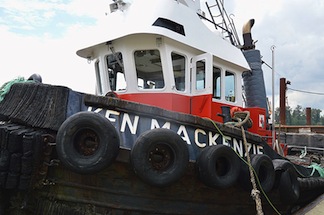The following is the text of a news release from the Tranportation Safety Board of Canada (TSB):
(RICHMOND, British Columbia) — In its investigation report (M16P0241) released Tuesday, the Transportation Safety Board of Canada found that an inadequate fuel hose connection for the generator caused the July 2016 fuel leak and fire on board the tug Ken Mackenzie in British Columbia.
On July 11, 2016, at approximately 2230 Pacific Daylight Time, the tug Ken Mackenzie, with two people aboard, reported a fire in the engine room while towing logs on the Fraser River in British Columbia. The two crewmembers abandoned the vessel by jumping on the log tow and were picked up by the assist tug Harken No. 5. The fire was extinguished with the assistance of vessels in the vicinity. There were no injuries.
The investigation determined that around 1900, during a scheduled crew change, the day shift crew informed the relieving crew that they had detected a smell of diesel fuel in the engine room. However, despite conducting safety rounds in the engine room, both crews were unable to find the source of fuel leakage, and so the vessel continued its voyage on the Fraser River.
Post-occurrence examination found that a connection between a copper tube and a flexible fuel hose for the generator was held together with a single hose clamp, and that the copper tube did not have serrations or a bead that would have helped keep the flexible hose connected. When this connection separated, diesel fuel sprayed onto components of the vessel's generator and ignited, causing the fire. Furthermore, the cables used for the fuel tanks' emergency shutoff valves, which were not designed to withstand elevated temperatures prevalent during a fire, seized in the conduit, thus making it impossible for the crew to shut off the fuel system.
If components for emergency equipment and machinery are installed or replaced by personnel without adequate guidance or knowledge of industry standards and are not inspected by a competent person before being put into service, there is a risk that the installation will be unsafe. Unsafe equipment and operating conditions may continue to occur if adequate regulatory oversight is not conducted for tugs less than 15 gross tons, putting people, property and the environment at risk.
Following the occurrence, the TSB issued a marine safety advisory letter to Transport Canada and a marine safety information letter to the vessel owners to provide information about the shortcomings concerning the control cables that were used on the vessel to operate emergency shutoffs for the fuel tanks.

